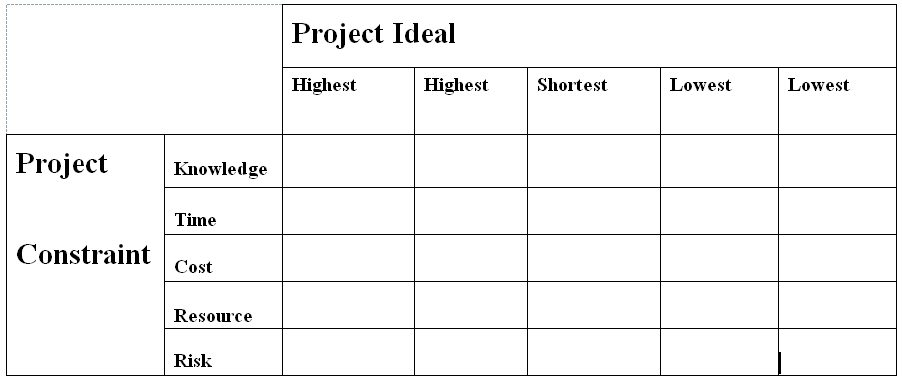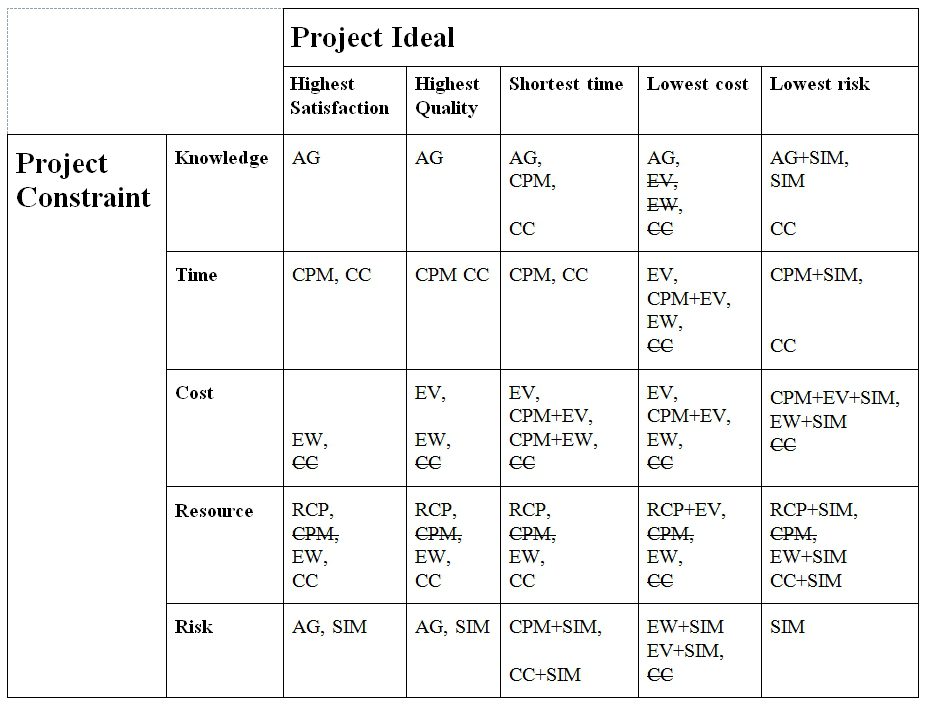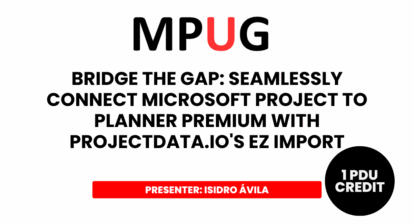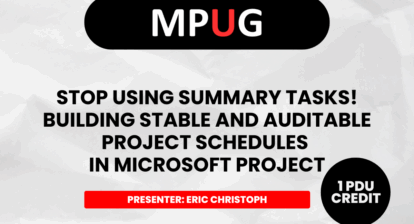 We have seen a flurry of articles on the versatility of agile, the solidity of the critical path method, the virtues of critical chain and the robustness of earned value. Is there one approach that is objectively the best? Is there one that performs best in any project situation?
We have seen a flurry of articles on the versatility of agile, the solidity of the critical path method, the virtues of critical chain and the robustness of earned value. Is there one approach that is objectively the best? Is there one that performs best in any project situation?
The original critical path doesn’t perform well when resources are slim. Critical chain doesn’t perform well when clients are interested in the cost side of projects. Earned value doesn’t do well in projects without budgets, such as when the monetary budgets are managed by people other than the project manager. Agile doesn’t do well when the client has a clear vision and wants to build the entire envisioned product, not just part of it. I think we have to conclude that there’s no single, best way to schedule a project. And if there isn’t one best way, it begs the question: How can you find out which of the approaches would be the best choice for your project situation? We’ll use two simple dimensions to characterize projects: project ideal and project constraint.
Project Ideals
What is a project ideal? An ideal provides a measure for success. Better achievement of the ideal will never satisfy a client because the project ideal can never be achieved. Improving on the project ideal gives companies a competitive advantage in the market place. Doing a project at the lowest cost possible is an example of a project ideal.
For example, organizations that develop new products often try to be the first to market. Their project ideal is the shortest time possible. These organizations would be happy if the product development lifecycle shrunk from 24 months to six months to three months — or better, to a single month (and best of all if it were all done yesterday). The ideal will never be achieved entirely; it guides your direction, but it is not a destination. When will we have new products that appear instantly?
Common project ideals are easily identified. Project managers typically strive towards one of the following:
Highest client satisfaction
Some projects have one client with an impossible challenge: for example, a new product development manager keen to prove his or her mettle. Other projects have many clients, and it will be impossible to keep all of them happy. Projects that create new policies, procedures or systems have many clients. A project that changes the salary system in an organization may have as the ideal maximizing the satisfaction of the employees. You’ll never satisfy all employees, but the challenge is to satisfy as many as much as possible.
Highest quality for deliverables
At the top-end of the market is where the competition on quality takes place. The competition often focuses on simply and objectively measured quality standards, like processor speed in the computer chip market, storage capacity in flash memory, energy-production in solar panels or energy storage capacity in batteries. They will never be high enough; the bar is always rising. Software development projects often suffer from bugs. Clients desire bug-free software, but that ideal will never be realized, unfortunately.
Shortest time possible
Research and development organizations that develop new products often try to shorten their development cycle to be the first on the market. If you could deliver yesterday that would be best. The current race for affordable solar panels and 500-mile car batteries are two examples.
Lowest cost possible
Implementation-type projects such as software or hardware upgrades often are cost-oriented. The knowledge exists, there are few unknowns and the goal is to do it most efficiently. If it could done for free, that would be best. Maintenance projects and regulatory-compliance projects are often in this category since these are projects that just cost money without generating extra revenue.
Lowest risk possible
Situations in which the possible risks are gigantic often require a lowest risk possible approach. Modifications to a nuclear-power reactor would be a prime example. The risk will never be zero, but the closer to zero, the better.
Project Constraints
How does a project constraint differ from an ideal? The difference is that the closer you come to the ideal, the more satisfied the client will be. The client won’t necessarily be happy yet. Only if constraints are met will the client be happy and the project considered successful.
Project managers face the challenge of maximizing the project ideal while respecting project constraints. Then if all goes well during project execution, the client will certainly be happy.
When constraints are met, the project isn’t necessarily successful, but it isn’t a failure either. Where ideals are the criteria for success, constraints are the criteria for failure. For clients, ideals are satisfiers, whereas constraints are dis-satisfiers.
The different types of project constraints are:
Knowledge-constrained
Knowledge projects are constrained by the speed with which new ideas or findings are generated to meet the quality requirements of the project. These are the typical R&D types of programs, such as new product development. There are many unknowns and the progress forward depends heavily on solving the scientific or technological problems and on receiving favorable test results. You can find many knowledge-constrained projects in the pharmaceutical, defense and high-tech industry.
Time-constrained
The project team faces the challenge to finish before a certain hard deadline. The project duration is driven by the logical sequence in which tasks have to be performed. Y2K-projects are prime examples of time-constrained projects; if it wasn’t done by the turn of 2000, the project had failed — or so the thinking went.
Cost-constrained
This type of project has a set budget. There simply is no more money available. The expenses have to be tightly managed to stay within the fixed budget. This seems to be the main concern, for example, in government projects where yearly budgets are often fixed. Common construction projects like bridge building and road pavement (not the high-profile construction projects) are often cost-constrained as well.
Resource-constrained
In this type of project, the availability of resources is limited and inflexible. Resources can’t easily be found (because of a scarcity of expertise), can’t be hired (because of hiring freezes) and can’t be trained (because of the nature of the expertise, special skills or talents required). The scarce resources drive the schedule more than the network logic. You’ll have to make do with the resources available, and if you can’t deliver the project product with the resources you have, the project fails.
Risk-constrained
Risk can be financial, reputation or public risk. The main concern of the project manager in private companies is to keep the financial exposure limited to a certain amount. In public projects, the negative public exposure of the project has to be kept to a limit for the organization. If a certain threshold of risk is exceeded, the grapevine or the press may expose those who are accountable. Many government projects are risk-constrained projects because if a public project gets negative publicity, the responsible politician may not be re-elected.
Analyzing your Project with PIC-Matrix
We can put ideals and constraints in a matrix. I herewith baptize this new framework as the “Project Ideal and Constraint Matrix” (PIC-Matrix). You should be able to characterize your own project on these two dimensions discussed. Simply identify the cell in which your current project would fall:
Let’s consider, for example, a high-tech product development project. The project creates a new computer product with which the organization tries to be first to market. The goal is therefore to complete this project in the shortest time possible, and the constraint may be that the product has to return at least the investment costs. This can be construed as a risk constraint. If it looks like the investment won’t be recovered, the project will be canceled. This project is a shortest-time possible, risk-constrained project.
Now that we’ve characterized the project in terms of its dominant ideal and dominant constraint, let’s determine the best scheduling approach for it.
The Current Project Scheduling Approaches
The main approaches we’ll consider are these:
Agile (AG)
Agile scheduling starts with establishing the functional requirements. It allows for continual scope and activity changes throughout the life of the project. It doesn’t require setting a baseline. The project health indicator is the answer to the following question that should be raised at every reporting period: Do you have a positive cost-benefit result and a feasible schedule for the next period (sprint)?
If you want to find out more about agile, a good book about a subset of agile called Scrum is Essential Scrum: A Practical Guide to the Most Popular Agile Process by Kenneth Rubin.
Critical Path Method (CPM)
The critical path is the longest chain of tasks in the network of dependencies of the project. Once you know your critical path, you would monitor it carefully during project execution to bring in your project on schedule. Two books I’ve found particularly useful are Project Planning, Scheduling & Control by James Lewis and CPM Mechanics by Murray Woolf.
Resource Critical Path (RCP)
The resource critical path approach is an enhancement to the critical path approach that takes logical dependencies as well as resource dependencies into account. In leveled schedules, the critical path often is fragmented and only the resource critical path drives the project duration.
There are currently only two books that explain the RCP-approach: Dynamic Scheduling and Forecast Scheduling by yours truly, Eric Uyttewaal.
Critical Chain (CC)
A further refinement of the critical path and resource critical path approach that addresses resource constraints, Parkinson’s Law, as-soon-as-possible scheduling and multitasking. Critical chain uses buffer management. The size of the remaining buffer indicates the health of the project during project execution.
The most useful book on critical chain scheduling I have found is Project Management in the Fast Lane by Robert Newbold.
Earned Value (EV)
Earned value is an approach that integrates time and cost. At each status, you determine the earned value and compare it to the planned value and actual cost to assess the schedule and financial health of the project. The authoritative book on earned value is Earned Value Project Management by Quentin Fleming and Joel Koppelman.
Earned Work (EW)
Earned work is a relatively new approach similar to EV but expressed in person hours (effort) rather than in money. At each status, you determine the earned work value and compare it to the planned work value and actual work value. There is no book published yet on this approach; it has just been implemented in a new add-in for Microsoft Project called CurvesPro (from my own company, ProjectPro).
Let’s Try out the Recommendation Matrix
We’ll now develop recommendations on which approach to use in the PIC-Matrix. When the name of the approach is shown in a cell, we recommend using that approach in your project. When the name of an approach is struck through like this, we recommend AGAINST using that approach. Even though simulation (SIM) isn’t a scheduling approach by itself, it can improve the approach in such a way that we recommend it in combination with the scheduling approach mentioned. If two different approaches are recommended as alternatives, we’ve separated them with a comma (,). Sometimes a combination of two methods is the best way to go and we’ve indicated this with a plus (+).
Recommendations
Here are our recommendations:
- We recommend agile (AG) when knowledge is constrained or when the ideal is the highest satisfaction or highest quality factor, since agile is a customer-oriented approach.
- We recommend critical chain (CC) when time is the project ideal, except for those scenarios where cost is the constraint. CC is a time-oriented approach to scheduling and has been proven to shorten projects; however it’s not suitable as an approach to control cost.
- We recommend using critical path method (CPM) when time is the dominant ideal or constraint.
- We recommend the earned value (EV) approach when lowest cost is the project ideal. But notice that we always recommend it to be combined with CPM or RCP because EV by itself doesn’t reliably tell you if your project will finish on time. We also recommend EV when cost is the dominant constraint. Earned value is the only approach that provides integrated time and cost control by itself. So it also fits when time is the ideal and cost is the constraint.
- We recommend resource critical path (RCP) approach in any resource-constrained project.
- We recommend earned work (EW) when lowest cost is the ideal (except when knowledge is the constraint) or when lowest cost is the constraint as well as when resources are constrained.
- We recommend enhancing the scheduling approaches with simulations (SIM) whenever risk is the dominant ideal or constraint. Simulation of schedules can quantify risk in a project in terms of time and cost. In a Risk-ideal and Risk-constrained project, you can only do simulation or apply other risk management practices not discussed in this white paper.
Recommendations against the use of an approach
- We don’t recommend EV or EW in knowledge-constrained projects because it’s too hard to create an EV performance baseline in projects that often change in direction.
- We don’t recommend critical chain (CC) whenever cost is an ideal or a constraint. The CC approach doesn’t give visibility on the cost side of a project at all; it’s purely a time-oriented approach. There are no valid indicators for cost in the CC approach other than actual cost, which is available to any approach.
- We don’t recommend using CPM when resources are constrained because the CPM approach assumes having access to unlimited resources.
If you categorized your project in a cell, you have probably found that you’re using the approach we recommend unless you haven’t heard of that approach. If you’re currently using a different approach, you should explore if you can still benefit from switching over to the approach that we do recommend.
The Wild Animals are Now Caged
We have now caged all the wild animals in the zoo of our project management world. Each scheduling approach gets its own cage or cell. Each approach has turned out to have its own assumptions, and we’ve revealed them in order to determine in which situation they can best be used. If you know your dominant project ideal and constraint, you can find the scheduling approach we recommend in the Project Ideal and Constraint Matrix (PIC- Matrix).
Our Project Ideal and Constraint Matrix (PIC-Matrix) is a situational framework to determine the best scheduling approach for your project. Please note that while this matrix and its recommendations seem valid to me, it still needs validation on a larger scale and by other practitioners. Please add your comments below.
This article is excerpted from a much larger whitepaper available with free registration on the ProjectPro website.
I’d like to thank Al Rusnak and Angelo Arcoleo, who served as technical editors on this article.
Image Source









David Squires
Eric great article, thanks. If readers are looking for a helpful book on the concept and practical application of Earned Work (EW) in a project manufacturing environment, try “Project Management for Profit” by Joe Knight.
John Williamson
Outstanding article, thanks for all of your contributions to the community. Please keep them coming!